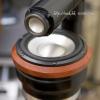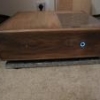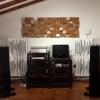Thank you friends. Since I setted up my second dedicated computer, I've studied countless ways to optimize the joint operation of both computers. I've been through many vagueness, many ideas, all of them with extraordinary demands that I have no intention of assuming. For example, if I were to build everything with absolute independence, I would need to build or buy two linear power supplies, buy two (at least) cases, a second transformer, a second power cord, a second power outlet, and so on (I calculated something close to €3.500.00). If I built computers in individual cabinets and an insulated linear power supplies, I would need to worry about the quality of the cable and the connection terminals between the power supplies and the computers and other elements (I quoted and found that good quality materials without no audiophile bias, would be more than $300.00, only by the connectors, not including the wires). That's why I decided to take advantage of the dimensions of my rack to build everything in a single enclosure, with strategic isolation and predispositions, so as to use a single power cord, reduce distances and allow direct connections, independent power and better internal wiring quality. Some interesting information, so that you may have a parameter for my future descriptions:
(i) As many who follow what I write should know, over the years, I've tried a multitude of materials to promote the vibration damping/isolation of my equipment, including mahogany, peroba, ivory, MDF, ebony, rosewood, itauba, angelim etc (I don't know exactly all English translations). My favorite, small in size, and by a good margin, is ebony, but for the dimensions I wanted to build, the easiest to find and most costly wood was peroba. It's a natural wood of very beautiful tone and sound, much better than ordinary MDF. The one I bought is from demolition, so it came with some nail marks that I needed to fix, but the end result was very good. The entire cabinet, including the fixing of spikes (also natural wood), was treated with natural material. Inside I used mineral oil, and outside I used pure beeswax. This is also due to the specific sound of the materials, which were carefully chosen not to introduce any type of falsification in sound. There are no risks in this because the wax gets stiff and the wood absorbs all the oil, which serves as a kind of insulator against moisture and other harmful agents that can cause deterioration over time.
(ii) The transformer has two 20v and 8A lanes, two 12v and 5A lanes and five 5v and 2A lanes. Secondaries to spare for any current computer. From what you can see in the photo, the ldovr linear power supplies (https://www.ldovr.co...7a4700-spsu.htm) that I used on the SSD and the USB card are definitive, and I bought two more for the future JCAT Net Card FEMTO I intend to use. These are the only ones. The processor's 12v power supply is just a prototype for sound experimentation, and the motherboard power supplies aren't definitive either. They are just taken advantage of the previous project.
(iii) The heating isn't worrying. One of my motherboards has a 10w TDP processor, and the other has a 35w TDP processor. As a precaution, I programmed the cooler to turn on when the temperature reaches 60ºC, but it has been turned off all the time. Never works, which indicates good thermal control. I also drilled ventilation holes at strategic points in the bottom of the case so that I could direct the airflow back and forth, cooling the entire case.
(iv) Although not aesthetically beautiful, I will use cork to cushion all computer components. That's why the back covers are fixed by cork, and so is the cooler. In the future, I will make cork "suspensions" for all the internal components of the computer, and I'll do this because, in addition to the wonderful sound of the cabinet wood, it introduces very natural and realistic features to the sound, makes it timbrically correct and more immune to vibrations.
(v) The new linear power supplies are amazing. Although specified for only 1A, the heating powering their corresponding devices (Samsung 850Evo SSD and JCAT USB Card FEMTO) is very small, and the stability is extraordinary. Set to 5v, the oscillation, for more, is just 0.01v, which made me very happy. At the preliminary hearings, the computers delivered a very surprising result, due to the change of cabinet and the addition of two more linear power supplies. For an expense of $25.00 for each power supply, I can say that the upgrade is significant and delivers result proportional to much more expensive power cables.
(vi) After approving a previous phase of sound experimentation, and hallucinating with the result that the two ldovr power supplies offered, I decided to partially finish the internal cabling (there's still a long way to go, including the transformer wires, which are all cluttered). So, I used for the JCAT USB card, SSD and processor the 20AWG Jupiter Pure Silver Cotton Insulated wire (https://www.hificoll...lated-wire.html). This cable was also handpicked, among several other models (Mundorf Silver-Gold - higher precision, but more analytical sound; Jupiter Pure Silver Cotton Insulated - excellent precision, focus and organicity; Duelund 1.0 Silver - good union between precision and warm sound, slightly less focus than Jupiter; Duelund 16AWG Copper - full-bodied, hot, more scattered/blurred sound). Because of the combination of features, I considered Jupiter the best combination for a high level digital source, as it allows for the delivery of a perfect musical image together with rich, organic, real and expressive sound. Make no mistake about the look of the white and listless cable. It is a Jupiter wire that has one of the best sounds I've ever known for application on low power devices. And, for the 24-way ATX cable, I kept the Kimber Kable 12TC, which just got a little messy inside the case, but I intend to improve in the future.
The sound is wonderful. It's one of the best digital transport I've ever heard. But, as I said, there's still a long way to go, so this topic will still have a lot of content added over time.
Hello Felipe did you have the transformer built specially for this project?
Best Regards Rob.
Hi Rob. Only now I saw your message. The transformer was made exclusively for my project. I'd like to have bought a very high level imported transformer, but this one I'm using is also very good, extremely quiet and well built. It's Brazilian and handmade.
- Speakers KEF Reference 203/2 with spikes;
- Schiit Freya preamp. (with Electro-Harmonix 6SN7 Gold-Pin tubes and Synergistic Research Orange Fuse) and Audio Research VS115 (with Tung-Sol KT120 and Svetlana 6H30 tubes and AMR Gold Fuse);
- DAC Ayre QB-9 192/24 + Furutech FI-03 ( R) + Synergistic Research Orange Fuse;
- Digital transport: the Control-PC is a dedicated computer with a Gigabyte H310N motherboard, a Intel Core i3-8100T processor, an Arctic Alpine 12 Passive Cooler, 16GB Corsair Vengeance DDR4 RAM 2400MHz, a JCAT Net Card FEMTO and 1TB Samsung 850 Pro SSD; the Audio-PC is a dedicated computer with a Gigabyte H310M M.2 2.0 motherboard, a Intel Core i3-9100T processor, an Arctic Alpine 12 Passive Cooler, 16GB Corsair Vengeance DDR4 RAM 2400MHz, a JCAT Net Card FEMTO and a JCAT USB Card FEMTO. Both computers use Windows Server 2019 Datacenter Core Mode (17763.737) with RAMdisk as Operational System, JPLAY FEMTO Alternative version, Minority Clean and Audiophile Optimizer v. 3.00 (1A in Control-PC and 4D in Audio-PC). Both also use hand made linear power supplies with a Furutech FI-06 ( R) NCF.
- Cables: Nordost Tyr (speaker), Nordost Valhalla XLR and Siltech 770i XLR (interconnects), Curious Evolved USB Cable, Nordost Valhalla Power Cable (DAC), Transparent PowerLink MM2 (power amp.), 2 x Purist Audio Design Canorus Praesto Revision Power Cable (power distributor and computers), Purist Audio Design Limited Edition Praesto Revision Power Cable (preamp.) and Jupiter Pure Silver Cotton Insulated (all internal wires from the computers).
- Acessories: Furutech GTX-D (G); Furutech GTX-D ( R) (x2); Sunrise Deep Line (x3); ebony spikes, carbon fiber bases; Nordost Qv2 (x3); acoustical and electrical reinforcements.






















